Samar folk seek shelter from storm in foxholes
QUINAPONDAN, Eastern Samar—Some families in parts of Samar and Eastern Samar would rather sit through the storm in burrows resembling foxholes or roadside ditches than take shelter in concrete buildings as another typhoon threatens to wreak havoc on their provinces.
On Friday, hours before the anticipated land fall of Typhoon Ruby, the brothers Jojit and Florencio Parajilla were almost done with their shelter—an eight-foot-by-three-foot burrow on a mountain in Barangay Parina, in Giporlos, Eastern Samar. It there was barely headroom for a child to squat inside.
“We started digging this just this morning,” Jojit,33, said in Filipino.
The burrow, locally called “kulong,” would shelter two families of the Parajillas, composed of eight people, among them small children. It was fortified with an iron sheet as a roof and “water-proofed” with sacks filled with clay-like soil on the top and on the sides.
 “And this is where we’ll put the machine gun,” Florencio, 24, joked when teased by the Inquirer that it looked like a wartime foxhole.
“And this is where we’ll put the machine gun,” Florencio, 24, joked when teased by the Inquirer that it looked like a wartime foxhole.
Jojit was explaining how they planned to fill it with just enough food supplies, when a team of local policemen arrived in the village, telling them with the use of a bullhorn to evacuate.
But the Parajillas were confident their burrow would keep them safe.
“The school they want us to move to is still under construction; it might collapse,” Jojit said. The local elementary school, he said, was destroyed by Typhoon Yolanda last year.
“It’s common here. There are some more of that in the mountains,” said the town’s police chief, Senior Insp. Sabino Araneta Jr. of the “kulong.”
However last year, during Yyphoon Yolanda, residents did not make build any such shelters and appeared “relaxed” about the weather disturbance, Araneta said.
“It’s (kulong) safe anyway,” Araneta told the Inquirer when asked what they would do with residents who refused to evacuate.
In Barangay Sto. Niño, also in Quinapondan, at least ten families would also not evacuate to school buildings. Instead, they built improvised “kubos” or huts that looked like tepees on the side of the road.
They were made of strips of coconut lumber and tarpaulin. Some of the families were cooking rice when the Inquirer team stopped by.
“Is the storm already veering away?” Bernarda Baguan, 68, said, as she and some of the children in what already looked like a tent city, approached the visitors.
Like the Parajillas, Baguan feared the evacuation center, also damaged by Typhoon Yolanda, was not strong enough for them.
Baguan said they were confident a storm surge would not reach them this time since they were on higher ground.
“The last time, I remember, I lost my shorts because I was holding my grandchild as we swam in the flood,” she said. She said she also lost two other family members during Typhoon Yolanda.
In Barangay Amambucale in Marabut, Samar, five families of the Balbalda clan still showed signs of trauma from Typhoon Yolanda. They also refused to go to evacuation centers and would rather stay in a roadside ditch.
The eldest of them, fisherman Matias Balbalda, 54, used a rope to tie old tarpaulins on the road railings. These three tarpaulins would serve as their roofs throughout the typhoon.
“We got scared the moment we heard (Typhoon Ruby) was coming,” said Matias’ son Andrew, 20.
The Balbaldas, including little children, were cooped up in the ditch. Andrew said they were banking on a large rock behind them should there be a storm surge. The family also cooked enough food to last them through the typhoon’s passage.
“We only brought mats, a few clothes, and water. Everything else, we left behind,” said Matias’ daughter, Marisol, 18. “If they get lost in the typhoon, we could recover those back anyway, but lives, never,” she added.














